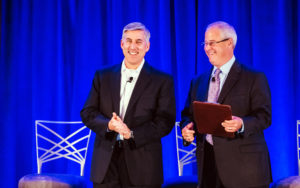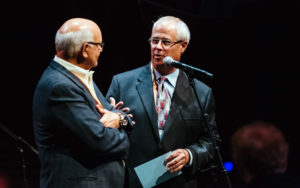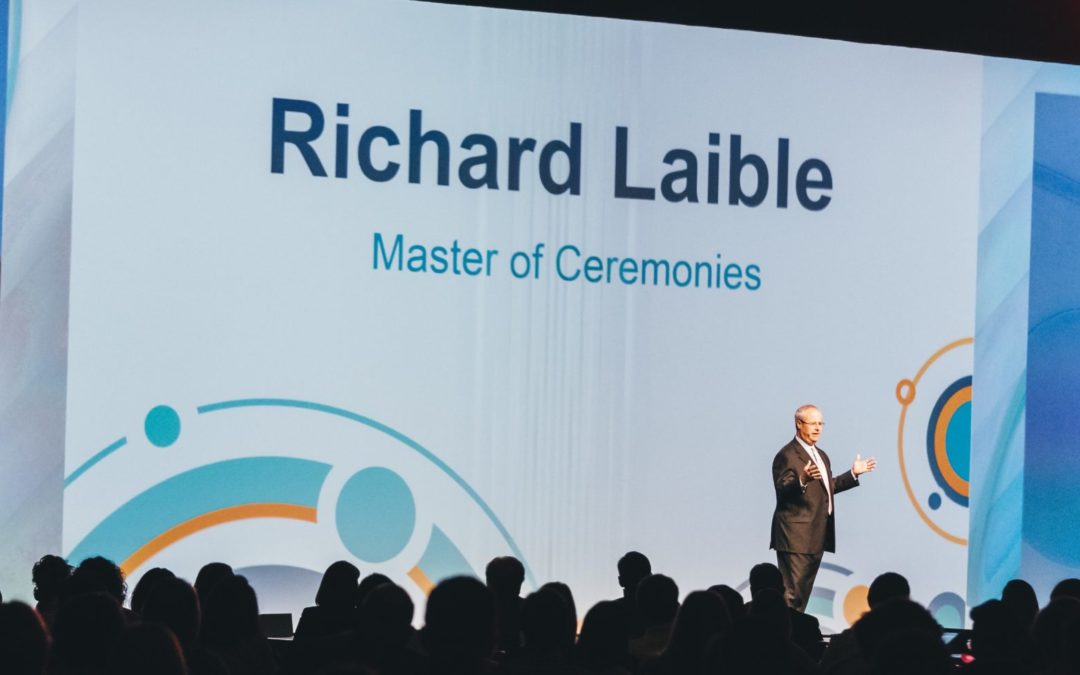Public speaking is listed as American’s #1 fear (death is at #5 & loneliness, weighing in at #7). Guess that means that most of us are less afraid of dying alone than of “making fools of ourselves” in front of others, which is a possibility if you emcee meetings and events.

But let’s say a boss said you MUST get in front of a group of any number of people and emcee meetings, a seminar, conference, awards dinner, or any other of a number of events. Well, the best way to overcome any fear you might have is to face that fear and be as prepared as possible in your new role as an emcee. I can’t stress enough that the more you’re prepared the less you’ll feel stressed, and the list below will be a huge help getting you there. So, here are my…
TOP TEN TIPS TO EMCEEING AN EVENT
- AGENDA – Find the agenda and make your own document just for you, the emcee. The items on this file include: times you are speaking, who you are introducing, questions you must ask, etc. all in ONE document that you can edit, use and refer to during the event. This is a living document that will be constantly changing, edited and added to right up until the beginning of the event…and don’t forget to print it out in a font large enough that you can easily read it from an arms-length away as you emcee meetings.
2. OPENING STATEMENT – I have learned from years of being on-stage and being an emcee and trade show presenter in front of audiences from twenty to over 10,000 that the first 10-15 seconds no one is listening to a thing you say when you emcee meetings. Many of them are finishing up a text, reading an email, still talking, settling in or even saying to the person next to them, “You know, he looks like Bob from accounting.” Therefore, most acts start out with the all too familiar, “How’s everybody doing tonight?!?! Let’s me hear it form you (insert city name)!!” My advice is to welcome everyone. reiterate the title of the event, reintroduce yourself and say something nice, truthful or even a little funny. Here’s an example: “Good evening ladies and gentlemen and welcome to Acme Foods 25th annual awards dinner. I’m your host Richard Laible and I must say, you people sure clean up well. Just look at all those fancy clothes. Do you like this suit? I got it for a steal…literally!””
3. JOKES – This is where you must be brutally honest with yourself: Am I a good joke teller? The clear majority of people believe they have a wonderful sense of humor, but from my experience, very few know how to really tell a joke well. It’s not a terrible thing to not be proficient at joke telling, unless you think you’re good. Nothing makes an audience more uncomfortable than having to sit through a bad gag … then gag they will.

A smile can be as loud as a laugh
Unless at one point in your career you were a professional comedian and you’ve polished your comedic skills in front of audiences, my advice is to steer clear of jokes, puns and witticisms. What I do suggest is being honest. Tell a true story or memory that supports the event. Examples could be how hard it was to prepare, the time something went wrong but all worked out in the end, a funny thing your kid(s) did, etc. And to this point, be in the moment and spontaneous. If something goes awry, don’t try and cover it up, mention it and move on. Honesty really is your best bet all the way around.
Still not convinced and adamant about telling a joke? Well, don’t write a new one as even the pros try them out first at small venues and clubs, then continue to hone them until perfect, and then and only then is the joke ready to become part of the act. And even then, professionals keep tweaking. You? You don’t have the same kind of time or inclination as a professional comedian so my advice is go to one of the countless websites with good jokes for all occasions. Then try it out at home and around the office first and ask people to be honest. See? There’s that word again!
Final word on jokes: don’t put it in the first 5 minutes of your time on stage. Wait until you and the attendees are comfortable with each other.
4. CORRECT TITLES & PRONUNCIATIONS – I have learned this the hard way throughout the years as I emcee meetings and events. You see, I have been given someone’s title and how to say their name, and then when actually introducing them find out that what I was provided was misinformation. People’s titles change often in business so I ALWAYS check with the person I’m introducing as emcee to hear it right from the horse’s mouth. Same goes for how THEY pronounce their name, then, on my notes spell it out phonetically (only you will ever see this). Say a speaker you must introduce is “Charlize Theron” (I wish), I write out Shar-leeze Theer-roun, then repeat it back to them. Everyone is happy when their name is said correctly. And I don’t look like a fool. My hardest name ever? Lakshmanan Krishnamurti. But, by using the tools above, I nailed it, to his surprise and mine!
5. INDEX CARDS– I prefer 5″ X 7″ index cards, and so did David Letterman. And always use colored paper which I try to match to the event’s colors (Staples has them in stacks of 500 with 5 assorted colors for about $8 ). This size is not as bulky or noticeable as 8×10 sheets of paper yet bigger than a 3X5 that just doesn’t hold enough information. It’s easy to adjust your printer setting to the size you choose and viola, you have professionally looking cards that are easy to handle and look good on stage. Also make sure you leave some room for notes of any last minute changes. Oh yeah, think about numbering them just in case you drop them, trust me, it happened…once!
6. WHAT TO WEAR – My Emcee’s Rule is one step above what the attendees are wearing;

The Clothes Make the Emcee
ATTENDEES EMCEE
Shorts/Tees Khakis & Sport shirt
Casual/Jeans Khakis & Dress shirt
Biz Casual Sport Coat & Slacks
Sport Coats Suit & Tie
Suit & Tie Nicer Suit & Tie
Formal Tuxedo
7. YOUR MOOD – If you’re in a “bad” mood, for whatever reason, get out of it. Take a few minutes prior to speaking and have a talk with yourself. Seriously. Go find a place a quiet place where you can be alone and literally, out loud, talk yourself into being in a better mood. Every audience needs you there and 100% present. You and they both deserve you not in a cranky mood, but ready to give the best event you can with nothing else on your mind but having a perfectly run event without any other drama cluttering your mind. Sure, go right back into whatever mood you want once the sow’s over and you’re completely away from the venue, attendees and clients. Off stage it’s your life, on stage it’s theirs!
8. ENGAGE – You will never feel more disconnected as an audience member as when a speaker stares at his or her notes, the screen, the floor…everything EXCEPT the people he or she is talking to. So, when you emcee meetings, engage your attendees by looking at them. Scan the room. You don’t have lock in on someone’s eyes, that’s uncomfortable for both of you. But glance around at the faces and even at the various parts of the audience. And, if you do catch someone’s eyes: smile, nod, then move on…that will draw that person in to keep listening to what you have to say as they are now your “presentation friend.”
Once, when I was presenting for a client, as a trade show presenter, in the theater of their trade show booth, in was the final hour of the last day of the convention, I only had one person sitting in a theater of 30 seats. I couldn’t just stare at this man for the next 10 minutes while I spoke so I pretended that there were a dozen people watching, most of them standing in the back. Well, I presented to them, making eye-contact to invisible people AND the guy sitting there from time to time. And you know what? I think he didn’t even notice, and if he did, I’m sure he appreciated it.
So, what I’m saying is, it’s more comfortable for you and the people you’re speaking in front of to make contact from time to time during your stint as emcee.
9. SMILE & SPEAK CLEARLY – Many speakers get so caught up with the information they are trying to get across they often forget they are still a human being talking to other human beings. So, going back to Tip #7, you’ve gotten yourself into the right mood, share that with the audience. A couple of ways to help you with this are really knowing your script and taking your time:
a) Your Script: You may have a complete script printed out on the podium in front of you or on a teleprompter. DO NOT READ THESE WORD FOR WORD! Period. Take the time to become very familiar with this so you are using the script to keep you place, referring to it only to keep you on track and to not miss any messaging. I always feel that when someone reads a script word for word I would rather have them just hand me the darn script, then let me read it myself saving us both a lot of time and trouble. Being very familiar with your script lets the audience know you are prepared and lets you stay engaged and in the moment. Remember eye-contact? Good.
The best bet is to speak from your heart, knowing what you want to say and merely using a brief one-page outline with words and phrases to keep you on task and knowing you touched on all topics you wanted to cover as you emcee meetings.
 b) Take Your Time: So, you’re dressed appropriately, you’ve gotten the finalized agenda and put down some simple notes on 5×7 cards along with your opening statement, a joke or two, everyone’s correct title & pronunciations, you’ve given yourself a mood pep talk with a smile on your face. Now, take a deep breath, smile again and go out their knowing you are prepared so there’s no reason to rush through this. You’ve already done all the grunt work, enjoy the fruits of your labors and take your time.
b) Take Your Time: So, you’re dressed appropriately, you’ve gotten the finalized agenda and put down some simple notes on 5×7 cards along with your opening statement, a joke or two, everyone’s correct title & pronunciations, you’ve given yourself a mood pep talk with a smile on your face. Now, take a deep breath, smile again and go out their knowing you are prepared so there’s no reason to rush through this. You’ve already done all the grunt work, enjoy the fruits of your labors and take your time.
There’s nothing more powerful than taking a well-timed pause to make a point, to stand back and let the audience laugh when you’ve said something funny, or to take a moment between topics to let what you’ve just said sink in. Now is not the time for urgency. Save that for the other people when they see you off-stage and congratulate you on a wonderful job emceeing their event.
10. PEOPLE ARE PULLING FOR YOU TO SUCCEED: People really do want you to do a good job – It took me a long time to realize that people weren’t waiting for me to fail, they were rooting me on to be successful. Many people are sitting there thinking (I go back to my opening sentence concerning people’s worst fear) “I’m just glad it’s not me up there.” So remember, when you emcee meetings, the audience isn’t your adversary, they’re you’re cheering section. Now go out there and emcee a great show!

Congratulations, you did it! BRAVO!!!!
(PS – if I can ever help you or you have any questions before you emcee meetings and events, just let me know here)
- Pronouncing People’s Names Right - March 1, 2019
- Writing a Speech, Talk or Presentation? These will help! - January 24, 2019
- Rules of Improvisation - December 27, 2018
- Engagement. Oops, I meant…Engage - October 31, 2018
- How To Write A Joke - September 30, 2018
- Professional Emcee or Facilitator? - August 31, 2018
- Trade Shows – It doesn’t take magic to get ‘em into your booth - July 25, 2018
- 5 SIMPLE TRADE SHOW TIPS - June 27, 2018
- Road Warrior’s Tips on Las Vegas - May 21, 2018
- Corporate Emcee: Hire A Professional And Not ‘Bob From Sales’ - April 30, 2018

